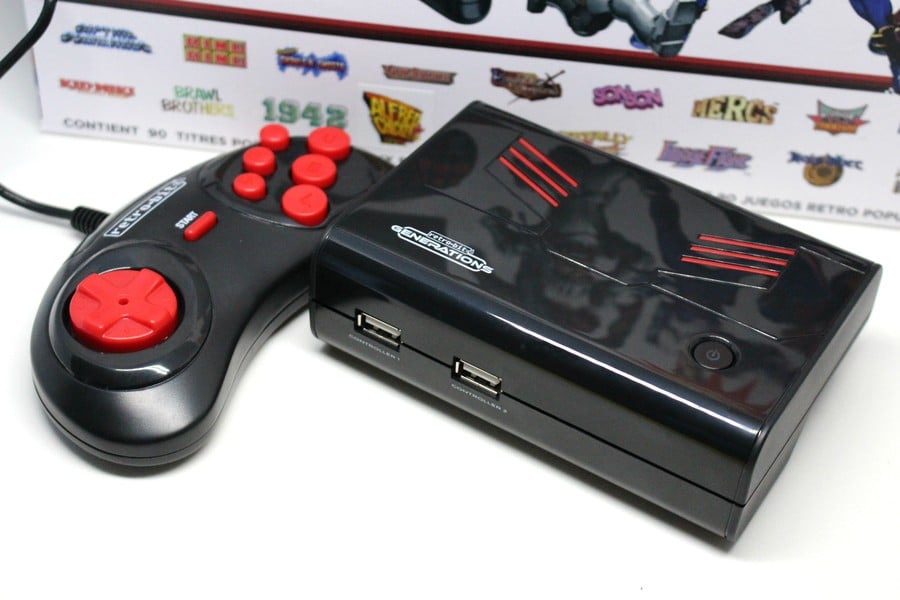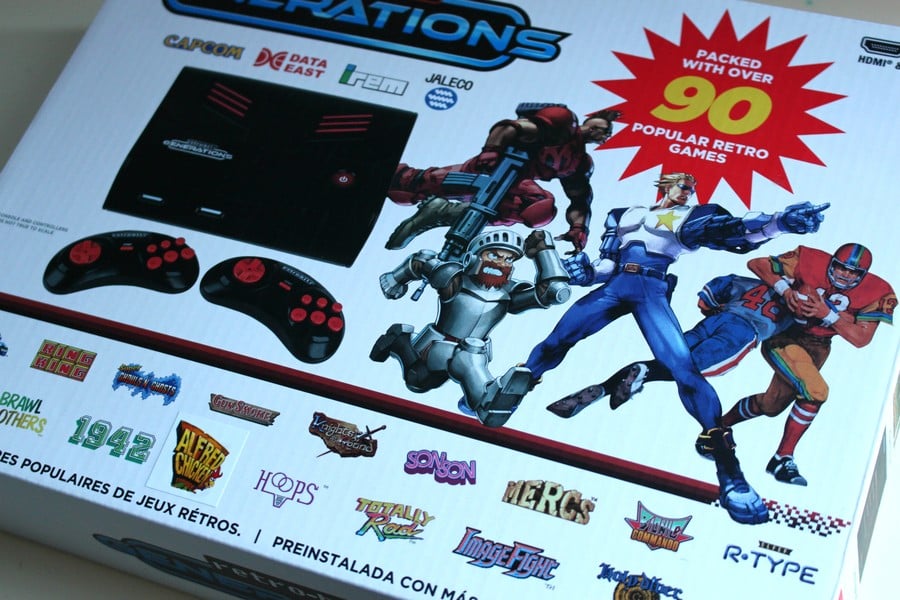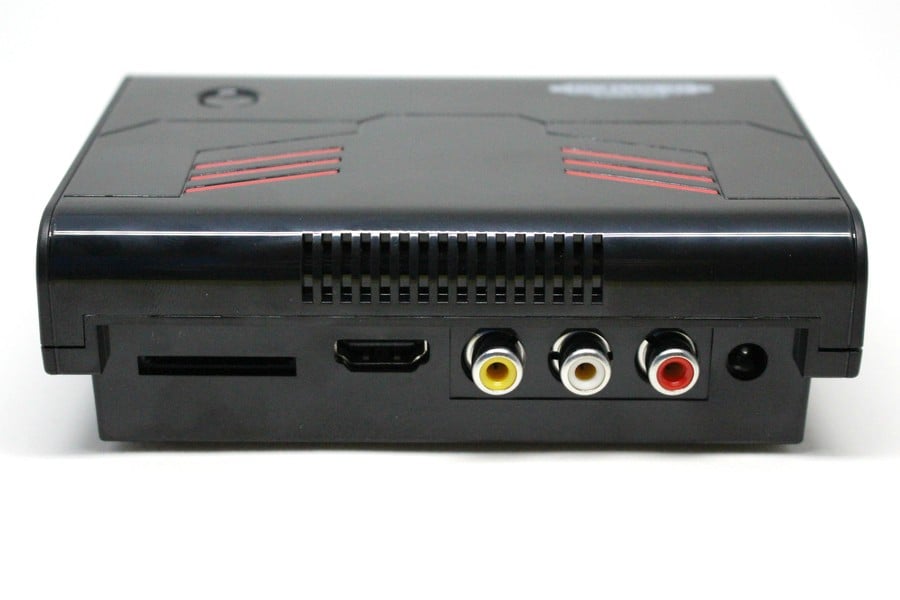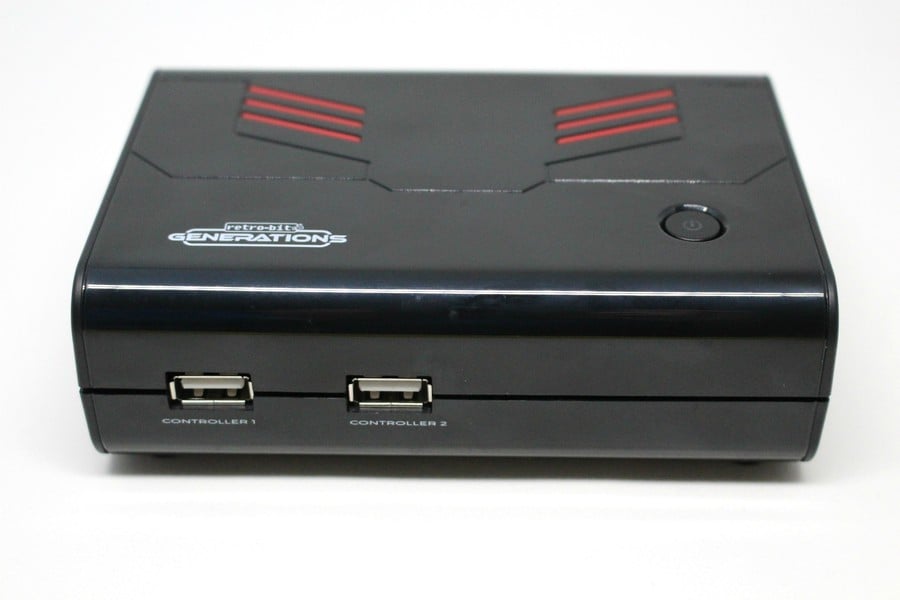
The NES Classic Mini is proving to be one of the must-have gaming items of 2016 with demand far outstripping supply and consoles selling online for way above the initial asking price. While Nintendo is clearly onto something of a winner here – despite the company's almost habitual desire to annoy buyers by not producing enough units – the concept of vintage hardware being cloned in the modern era isn't a new one, and Retro-Bit is a company which has been fairly active in this arena for quite some time.
The firm has already produced systems like the Super Retro Trio and Retro Duo Portable, and it timed the announcement of its latest system perfectly. No sooner had the hype died down from Nintendo revealing the NES Classic Mini that Retro-Bit proudly unveiled the Retro-Bit Generations, a conceptually similar plug-and-play console that not only showcases classic NES games but also Mega Drive, Game Boy, SNES and even arcade titles. With names like Capcom, Irem, Jaleco and Data East all officially signed up, this pint-sized system looked incredible on paper, but in reality things are sadly less impressive.
What Is The Retro-Bit Generations?

Like the NES Classic Mini, the Retro-Bit Generations uses emulation to replicate the performance of vintage hardware. However, while Nintendo's mini-console was focused entirely on the NES, the Retro-Bit Generations features NES, Game Boy, SNES, Mega Drive and arcade releases. It outputs either via standard composite AV or HDMI, and boasts the ability to save your game data at any point. You can also save your games to an SD card thanks to the included slot, and the custom user interface allows you to configure the button arrangement and tinker with audio and visual settings. The system costs $59 in North America.
What's In The Box?

In addition to the console – which is a close match to the NES Classic Mini in terms of size – you also get two controllers which are modelled on the Sega Mega Drive / Genesis 6-button pad. There's also a power supply (North American, but you can use an adapter if you're elsewhere in the world) and AV cable, but no HDMI lead – you'll have to find your own.
It's worth noting that while the controllers have USB connectors (at the end of a generous length of cable, it should also be noted), we couldn't get any other USB pads to function on the device. The pads are actually really comfortable to use, so the fact you can't substitute them isn't a deal-breaker; the rolling D-pad is precise and the buttons feel decent enough.
What Games Are Included?

Depending on where you look, the Retro-Bit Generations has between 90 to 100 different games included. The finished list is clearly in a state of flux right now; the packaging we received the console in says 90, but the game list has been covered up by a new sticker, which indicates last-minute changes to the line-up. Retro-Bit has informed us that consoles sold after November 25th will boast revised packaging which states that 100 games are included.
Despite securing the official blessing of Capcom, Irem, Data East and Jaleco – or, in the case of the latter three, the blessing of the companies which now own the IP of these firms – there's an awful lot of filler included. Capcom fans will love the fact that Ghouls 'n Ghosts (arcade), Super Ghouls 'n Ghosts (SNES), Mercs (the Mega Drive version), Knights of the Round (arcade) and Captain Commando (arcade) all make the cut, but so many of the company's big hitters are absent. There's no Street Fighter 2, no Final Fight and no Strider – three games that the average Capcom fan would regard as essential offerings. The story is largely the same with the other companies; Data East's biggest games are nowhere to be seen, and in the case of Irem the versions of R-Type that are included are the SNES editions rather than the superior arcade instalments. Even Image Fight is the NES port of the game, rather than the arcade original.
However, there are some interesting picks to be found regardless. SNES side-scroller Legend is an attractive and enjoyable game which is getting a new physical release soon, while Dorke N Imp never actually got released during the lifespan of the SNES and is therefore something of a hidden gem. NES fans who can't get their hands on the NES Classic Mini are well served by the large selection of big-name titles, including 1942, Bionic Commando, 10 Yard Fight, Kickle Cubicle and Kid Niki Radical Ninja.
There are other examples of region-specific titles which will be fresh and new to western gamers, but there's no escaping the fact that the selection of titles feels like a random assortment of whatever Retro-Bit was able to legally get its hands on, rather than a definitive list of solid-gold classics. For example, Sword of Sodan – one of the few Sega games included here – was critically panned even back in the early '90s, so goodness knows why anyone would want to play it in 2016.
Performance
The Retro-Bit Generations might have a somewhat random library of games but this isn't the biggest issue with the console by a long chalk. A more pressing concern is the general emulation performance of the platform, which varies from acceptable to downright unplayable. Game Boy and NES titles – perhaps the least demanding from a technical standpoint – run relatively well, although the image quality is quite fuzzy, especially on low-resolution Game Boy games. While you can adjust the display settings to Stretch, Full Screen or Original Size, none of these options deliver a pin-sharp picture like the one seen on the NES Classic Mini. Full Screen mode when playing Game Boy games is practically as bad as using composite AV, with pixels being lost in a soupy, ill-defined mess.
Moving onto the more powerful systems such as the Mega Drive, SNES and arcade, things take a notable turn for the worse. None of the games produced for these systems run at anything approaching full speed, and all are plagued by a constantly fluctuating frame rate and inconsistent audio. Take R-Type 3's opening level, where you pilot your R-9Ø Ragnarök through a debris field. The frame rate plunges alarmingly and the music actually slows down, but once you emerge from the other side and the number of sprites on-screen drops, the whole game speeds back up again. This occurs in practically every game on the console to a certain degree, but is more noticeable on arcade releases. For some reason, the Sega home port of Mercs has worse frame rate problems than almost every other title on the console, rendering it almost unplayable.
Another problem is that sound emulation across all formats is a little off; certain elements of the instrumentation are plain wrong, while others deviate just enough from the original to stick out like a sore thumb. Elsewhere, the audio is so hilariously garbled that it bears almost no resemblance whatsoever to the original music. Jaleco's SNES side-scrolling fighters Rival Turf and Brawl Brothers are the worst offenders in this regard; at times it sounds like the soundtrack has been possesed by some kind of demonic, free-form jazz artist.

An indication of just how little time has been spent fine-tuning the experience is given when you boot up Capcom's arcade-only, vertically-scrolling shooter Varth: Operation Thunderstorm. The entire display is flipped on its side – as it would be in the arcade – and there's no option to spin it 90 degrees so it's playable on your widescreen TV set. While it's still possible to play the game (crippling emulation problems aside), it's hardly ideal.
It's hard to know where to pin the blame here; perhaps the emulator that Retro-Bit has used simply isn't good enough to accurately replicate the performance of these vintage platforms, or maybe the off-the-shelf chipset inside the machine is too weak to do the software justice. Whatever the reason for the dire performance level, the message is clear – don't expect a faithful representation of any of the games included in the system's memory.
Conclusion

The Retro-Bit Generations sounded like the dream console for many players, and that includes us at Nintendo Life. While the NES Classic Mini hits a spot, we've always wanted a system which allows us to not only play obscure classics from back in the day, but also offers a legal means of enjoying coin-op titles which – were it not for emulation – would simply be lost in the mists of time. Just imagine a plug-and-play platform which had Capcom's entire CPS1 and CPS2 arcade output on tap; arcade-perfect replications of the coin-ops you played as a kid that never made it to home systems – or, if they did, were merely pale imitations of the real deal.
The knowledge that the Retro-Bit Generations would showcase some arcade games was enough to get us seriously excited when it came to opening up its packaging, but the actual machine feels like a broken promise. Sure, the Game Boy and NES titles run well enough and you're getting three times the number of games that ship on the NES Classic Mini, but in terms of pure performance and overall user experience, Nintendo's offering wins hands down.
Anyone even vaguely interested in the console and the games it features will no doubt already consider themselves to be a serious retro gamer, and therefore should already be familiar with how to emulate these same titles on other hardware with much more agreeable results. While that might be a legal grey area, that represents a much better option than spending money on a product such as this which, while official, offers an unforgivably compromised experience.
This article was originally published by nintendolife.com on Fri 18th November, 2016.






Comments 31
Um....Not interested after I heard some problems at last.
It looks cheaply made. Pass. Go pokemon Sun and moon!
Doesn't sound very good at all from that review.
There's a random [imag under a group of pictures.
What a shame. I love what this console wants to be. The right company behind a machine like this could rule the market. Would be a great way to preserve wonderful old games and lost arcades.
One of my bud bought one of these after failing to find an NES Classic Edition at store shelves and now he regret ever buying it as 70% of the games on there were disgustingly terrible. Now he went to lock himself in his room crying cause he just lose $60 to a product he never meant to buy. The poor guy, damn you Nintendo you ruin him.
Woooooooooow. Faaaaaail
Love the idea. Seems ok
@Meowpheel Thanks, all sorted now
And that's why people are willing to pay for the NES Classic - part of it is nostalgia, but part of it is trust that the quality will be up to snuff.
I knew it all sounded to good to be true. I know I shouldn't expect much from a 60 bucks system, but still... I will gladly take 30 perfectly emulated games to 100 "so, so" ones any time. No deal for me.
Nah. However, going for the Supa Boy S that comes out in December!
Bootleg machines like this are a no buy for me. Bought one once and never again.
Pleasantly surprised the controllers sound good. I love Genesis/Mega Drive pads, but I was worried they'd ruin the feel. I recall they said other usb controllers were supposed to be compatible, so that's unfortunate. And a real shame about the performance and usability issues. There are some very good games on this. There's no good excuse for the performance problems.
I swear all these retro machines make simply emulating them on PC the better way to go. Not saying I condone or oppose, just giving a perspective.
So basically it sucks.
Ew, the controllers... they seem so cheaply made. Not pretty... :x
Bad quality emulation kinda defeats the purpose, no?
The review says it all really: Pretty disappointing.
I think I'll just wait for the SNES Classic Edition/Mini.
Although, the AVS is a pretty sweet retro console too:
http://www.inceptional.com/2016/11/10/the-retrousb-avs-is-a-nes-clone-worth-checking-out/
Or the rather expensive but still very cool Analogue NT:
http://www.inceptional.com/2016/08/24/this-analogue-nt-mini-gif-gives-me-the-feels/
And I think there's a couple other good options that I can't quite remember off the top of my head.
Edit: What's that one where you can play multiple different physical game console's games on one system . . . oh, yeah, the Retron 5 too:
http://www.nintendolife.com/news/2014/08/video_hyperkin_retron_5_review_king_of_the_clone_consoles
My issues:
Can't flip the display on Varth to vertical...really?
Black n white GBoy games on an HD display?
Missing games previously listed on their website!
Yes there is a lot of slowdown with certain titles!
Many classics missing from these license holders and with odd choices chosen instead!
But Overall though it's still ok to mess around with here and there and doesn't take up any space to keep hooked up!
Now I'm hoping it Sells well enough for them to do a revised unit next year(or sooner) and improve in all these areas I mentioned above, increase the game list with more popular titles and get rid of the black and white GB games! Yes This review will not help their cause for any retro gamer that was leaning towards a purchase but here's hoping!! Meanwhile I continue to have fun with Atari flashback 7 and the colecovision flashback from 2015! 😊
There's no point in making one of these unless the emulation is near perfect, the game list is full of classics, and the controllers are also true to the original design. Nintendo seems to be the only company that can make that happen, so here's hoping that SNES Mini is up next.
they forgot some ace games too...night slashers arcade and boogie wings arcade...games no one here probably knows anything about
@NinChocolate Well, it works for Sega and their Steam classic games, right?
Sad to hear I was wrong about this one. Hopefully the ambitiousness behind its release will inspire future plug-n-play products to do it right, next time, and to still remain unique and of strong value.
A bit unfortunate the Retrobit does not work with alternate controllers. The first controller I pulled out of the box, the Dpad sometimes fails to respond when pressing down. It is painfully obvious while scolling the menu.
I did a quick list of all 100+ games featured. Mine is the retail box with the "100" games decal on it:
https://www.youtube.com/watch?v=aCeYAr-UxPo
Yes, Alfred Chicken is on the retail units with "100 Games" Blazon.
Thats a real shame, ive bought a nes mini and i would have bought one of these but whilst the game list doesnt bother me as i liked the idea of some random obscure titles. the emulation has to be good! the nes mini is perfect! any new plug and play needs to model itself on that. if they can have near that quality or better there onto a winner!.
Hmm, I believe it would be much better to just get a Rapsberry Pi 3B, equipped with newest RetroPie, and there you go, all your retro games covered. I've been using one lately and it's quite impressive - an overclocked RasPi even runs hardware demanding DOS games very well (System Shock, Blood, BioForge, Quake runs well too, but on lower res), not to mention SNES or GBA - these are a breeze.
Whilst i understand the raspberry pi idea, i think the beauty of these pre-loaded machines is just that . its all ready to go! i dont think a lot of people want to faff around with a raspberry pi putting it all together etc.
At least you can actually buy the thing.
Utter junk, i know no reason why anyone wouild look at this and want it. the system itself is dreadful, copied controllers, rubbish game lineup.
I wonder is a firmware update via usb or sd card would fix some or most of the problems?
Leave A Comment
Hold on there, you need to login to post a comment...